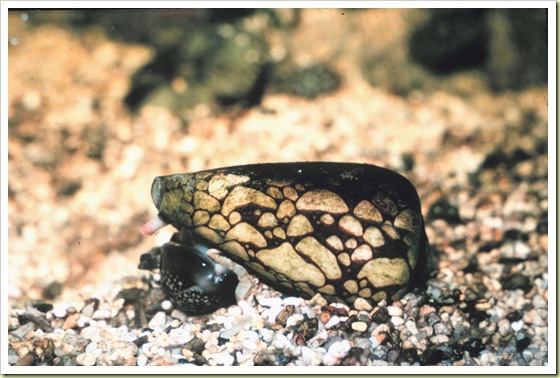
This little beautiful looking Marbled Cone snail can be as deadly as any other animal on this list. One drop of its venom is so powerful that it can kill more than 20 humans. If you ever happen to be in warm salt water environment (where these snails are often found) and see it, don’t even think of picking it up. Of course, the true purpose of its venom is to catch its prey.
Symptoms of a cone snail sting can start immediately or can be delayed in onset for days. It results in intense pain, swelling, numbness and tingling. Severe cases involve muscle paralysis, vision changes and breathing failure. There is no antivenom. However, only about 30 human deaths have been recorded from cone snail envenomation.
Conus marmoreus, common name the "marbled cone", is a species of predatorysea snail, a marine gastropod mollusk in the family Conidae, the cone snails, cone shells or cones. It is the type species for the Conus genus. This is a species which is believed to feed mostly on marine molluscs including other cone snails.[3][2]
This snail is venomous, like all cone snails. There is one subspecies: Conus marmoreus bandanus Lamarck
Distribution[edit]
This species occurs in the Indian Ocean along Chagos and Madagascar, in theBay of Bengal along India; in the western part of the Pacific Ocean to Fiji and theMarshall Islands.
Shell description[edit]
The size of an adult shell can vary between 30 mm and 150 mm. In this species, the shell color can range from black with white dots, to orange with white reticulations, so arranged as to expose the white in rounded triangular large spots. The aperture is white or light pink.[4]
References[edit]
- ^ Linnaeus, C., 1758. Systema Naturae per Regna Tria Naturae, 10th ed., 1
- ^ a b "WoRMS". Conus marmoreus Linnaeus, 1758. World Register of Marine Species. July 29, 2011. Check date values in:
|year= / |date= mismatch(help) - ^ "Conus marmoreus". Penelope.uchicago.edu. Retrieved 2013-07-12.
- ^ George Washington Tryon, Manual of Conchology vol. VI, p. 7; 1879
- Dautzenberg, Ph. (1929). Mollusques testacés marins de Madagascar. Faune des Colonies Francaises, Tome III
- Filmer R.M. (2001). A Catalogue of Nomenclature and Taxonomy in the Living Conidae 1758 - 1998. Backhuys Publishers, Leiden. 388pp
- Tucker J.K. (2009). Recent cone species database. September 4, 2009 Edition









No comments:
Post a Comment